Section#18: Cost-optimal EREW PRAM sort
(CS838: Topics in parallel computing, CS1221, Thu, Apr 1, 1999, 8:00-9:15 a.m.)
The contents
- Standard Even-Even Merge Sort on EREW PRAM
- Cost- and time-optimal merge operation on EREW PRAM
- Proof of correctness of the cost-optimal merge operation
- Complexity of Cole's EREW PRAM Merge Sort
Standard Even-Even Merge Sort on EREW PRAM
Recall the Even-Even Merge Sort (EEMS) algorithm from Section #17. It was based on the Even-Even Merge operation. EEMS can be easily implemented on EREW PRAM, since all parallel CE operations are performed on disjoint pairs of numbers in all steps. Let us give another proof of correctness of the merge operation, this time not using the 0-1 Sorting Lemma (with some changes in the notation).
Lemma
Let N=2k and L[1,...,N] and R[1,...,N] be two monotonically ordered sequences.
Let Z={EEMerge}(L,R) be the resulting merged sequence of length 2N.
Then Z={Pairwise_CE}({Even_Odd_Interleave}(OM,EM))
where EM[1,...,N]={EEMerge}(even(L),even(R)) and
OM[1,...,N]={EEMerge}(odd(L),odd(R)).
Proof
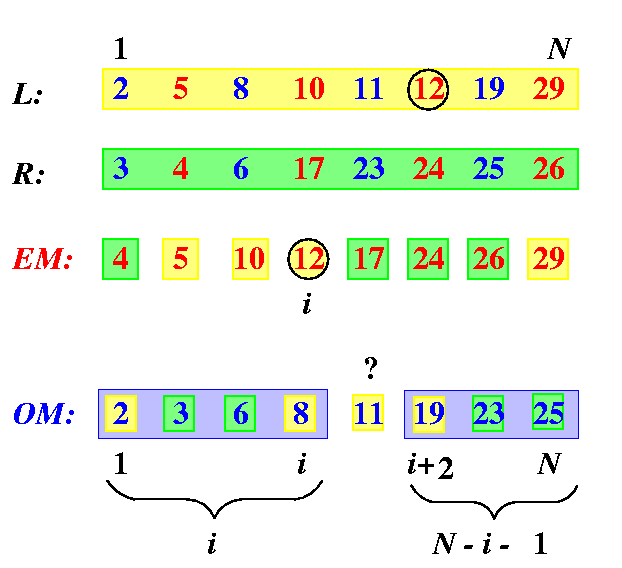
CAPTION: An illustration of the reasoning in the non-binary proof of correctness of the classical Even-Even Merge operation.
Consider any number z=EM[i], 1<= i<= N. Then
- every number EM[k], k<= i, comes from an even-numbered position in L or R. In its original sequence, it is therefore preceded by exactly one odd-position number which now appears somewhere in OM. It follows that all the numbers OM[1,...,i] must be < z.
- Except for 2 numbers (the last numbers in L and R), every number EM[k], k>= i, is followed in its original sequence by exactly one odd-position number, which now appears somewhere in OM and so (N-i+1)-2=N-i-1 numbers in OM must be greater than z, i.e., all the numbers OM[i+2,...,N] are > z.
We can therefore conclude that (see Figure )
the only uncertain number in OM with respect to EM[i] is OM[i+1]
That is why
we just need to perform CE(EM[i],OM[i+1]) to put these two numbers in order.
The same result can be achieved using a slightly different reasoning, using an additional information about the original position of z in its original sequence.
Lemma
Let z=EM[i] be the number on i-th position in EM and let j be the original index of z in its original input sequence, say L (the statement for input sequence R is exactly the same). Hence, z=L[j]. Let f(z) be the final position of z in the final sequence Z.
We claim that 2i<= f(z)<= 2i+1.
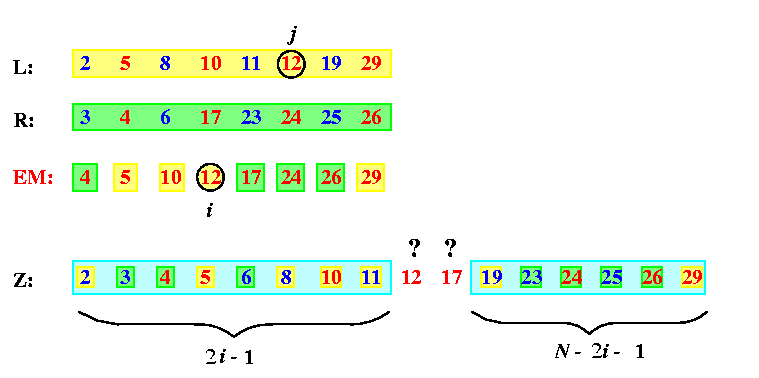
CAPTION: An illustration of the alternative proof of Even-Even Merge for N=8, z=12, i=4, and j=6.
Proof
This lemma says that if we know EM, we can determine for any zin EM its final position in Z with the precision of 1 and we need one CE operation to determine the exact final position of z in Z.
Assume that we know only EM and we would like to determine the final positions in Z of numbers on odd positions, i.e., of numbers in L\cup R-EM, but without knowing the sequence OM, i.e., without performing the second merge merge operation. In general, it is impossible. See Figure for a typical situation.
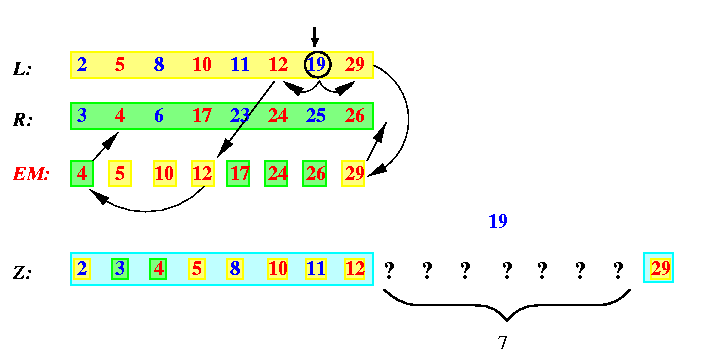
CAPTION: Knowing only EM, we cannot decide final positions of numbers from L\cup R-EM in Z.
The number 19 in sequence L must be preceded in Z by 6 numbers for its original sequence L, but since its predecessor in L, number 12, is preceded in EM by only number 4 from R, we can be sure about only two predecessors from R of 19 in Z, numbers 3 and 4. Since the successor of 19 in L, number 29, is the last number in EM, we do not know at all which numbers from R must follow 19 in Z. Hence, 19 can potentially end up on any of 7 undecided positions in Z.
But it turns out that with some additional O(N) computation, we can determine exactly the final positions of the odd-positioned numbers without performing the operation {EEMerge}(odd(A),odd(B)). And this is the main idea of the cost-optimal EREW PRAM MergeSort, which is also called Cole's merge sort: in each level of EEMS, to apply recursively only one even-even merge operation and perform some auxiliary O(N) computations to find the final position for all numbers in L\cup R. The idea of the auxiliary computation is to find for every number in xin L\cup R-EM the index of the largest yin EM such that y < x.
Then the number of CE operations for the merge operation of 2N numbers is given recurrently by equations
cm(2N) = cm(N) + O(N)
This equation has solution cm(2N) = O(N), since N+N/2+N/4+...+1=2N.
Therefore, the total number of CE operations of the whole EEMS algorithm is then
cs(2N)=2 cs(N)+ cm(2N)=O(Nlog N).
Cost- and time-optimal merge operation on EREW PRAM
Let EffMerge denote the cost-optimal merge operation. We will first give a pseudocode of EffMerge and then prove that it works.
function {EffMerge}(L,R) returns Z;
input EM,L,R: array[1,...,N] of T= record { Val: int; Origin:{L,R}; OrigIndex: int};
output Z: array[1,...,2N] of T;
auxiliary
OrPI,OpPI: array[1,...,N] of int;
(* OrPI[i] = index of predecessor of EM[i].Val in its original array EM[i].Origin *)
(* OpPI[i] = index of predecessor of EM[i].Val in the opposite than original array *)
LPI,RPI: array[1,...,N] of int;
(* LPI[i] = index of predecessor of EM[i].Val in L *)
(* RPI[i] = index of predecessor of EM[i].Val in R *)
LEMPI,REMPI: array[1,...,N] of int;
(* LEMPI[i] = index of predecessor of L[i].Val, i is odd, in EM *)
(* REMPI[i] = index of predecessor of R[i].Val, i is odd, in EM *)
FI: array[1,...,2N] of int;
(* FI = final indexes of numbers from L\cup R in Z *)
begin (* merge recursively the even-numbered subsequences *)
EM={EffMerge}(even(L),even(R));
(* Phase A: calculate indexes of predecessors for all numbers from EM in L and R *)
for all i=1,...,N do_in_parallel {
OrPI[i]:=EM[i].OrigIndex-1;
OpPI[i]:=2i-EM[i].OrigIndex;
if EM[i].Origin=L then { if OpPI[i] < N and R[OpPI[i]+1].Val < EM[i].Val
then OpPI[i]++}
else { if OpPI[i] < N and L[OpPI[i]+1].Val < EM[i].Val
then OpPI[i]++};
}
(* Phase B: rename arrays *)
for all i=1,...,N do_in_parallel
if EM[i].Origin=L then { LPI[i]:=OrPI[i];RPI[i]:=OpPI[i]}
else { LPI[i]:=OpPI[i];RPI[i]:=OrPI[i]}
(* Phase C: calculate indexes of predecessors in EM for all elements from L\cup R-EM *)
for all i=1,...,N do_in_parallel {
if LPI[i-1] < LPI[i] and LPI[i] is odd then LEMPI[LPI[i]]:=i-1;
if RPI[i-1] < RPI[i] and RPI[i] is odd then REMPI[LPI[i]]:=i-1;
}
(* Phase D: calculate the final positions in Z *)
(* D1: calculation for EM *)
for all i=1,...,N do_in_parallel {
FI[i]:=LPI[i]+RPI[i]; Z[FI[i]]:=EM[i];
}
(* D2: calculation for L-EM *)
for all i=1,...,N-1 do_in_parallel {
j:=LEMPI[i];
if L[i].Val > R[RPI[j+1]].Val then FI[i]:=i+RPI[j+1]
else FI[i]:=i+RPI[j+1]-1;
Z[FI[i]]:=L[i];
}
(* D3: calculation for R-EM *)
for all i=1,...,N-1 do_in_parallel {
j:=REMPI[i];
if R[i].Val > L[LPI[j+1]].Val then FI[i]:=i+LPI[j+1]
else FI[i]:=i+LPI[j+1]-1;
Z[FI[i]]:=R[i];
}
end
Proof of correctness of the cost-optimal merge operation
Lemma
The algorithm of EffMerge calculates correctly the final positions in Z of all numbers from L\cup R.
Proof
The pseudocode above is a bit simplified, since it does not specify the behavior at boundaries of the sequences. In general, we may assume that L,R,EM are sequences of N+2 elements, augmented by a left sentinel -inf ty at position 0 and a right sentinel +inf ty at position N+1 so that the first and the last numbers in them are treated equally as the internal numbers. In the proof we will abstract from these details.
- Phase A:
- The proof is very similar to Lemma .
Assume wlog that z=EM[i] has z.Origin=L. Let j=z.OrigIndex. Then z is preceded in EM by \alpha=j/2-1 numbers from L and the remaining \beta=i-1-\alpha=i-j/2 numbers are therefore from R, each of them preceded by an odd-position number there. Hence, z must be greater than 2\beta=2i-j numbers in R. At the same time, the number at the next even position in R, i.e., the number L[2i-j+2], must be greater than z, since it follows z in EM. So the only uncertain number in R w.r.t.~z is at position \gamma=2i-j+1. Figure shows the values in the array OpPI for our example above.

CAPTION: Array OpPI: the indexes of predecessors of numbers from EM in their opposite input sequences.
- Phase B:
- The aim is to make the names of predecessor indexes independent on the origin of z. The predecessor of z=EM[i] in L has simply index LPI[i] and the predecessor of z=EM[i] in R has index RPI[i].
- Span of RPI and LPI:
-
Before we prove the rest, let us show a useful auxiliary statement on properties of indexes LPI and RPI, which basically means that adjacent LPI or RPI indexes are never more than 2 apart.
Proposition
For any i, 1<= i<= N, LPI[i+1]-LPI[i]<= 2 and the same for RPI.
Proof
Figure shows the only two possible cases if LPI[i+1]-LPI[i]=3. In both of them we can derive a contradiction, and the same contradiction appears if LPI[i+1]-LPI[i] > 3.
- case (a):
- Since LPI always points to the largest less number in L, we have e1 < e<= o1. But o1 < e2 < o2 < e' and therefore e < e2 < e'. And this is a contradiction with assumption that e and e' are adjacent numbers in EM with nothing in between.
- case (b):
- Similarly, o1 < e<= e1 < o2 < e2 < e' leads to e < e2 < e'.
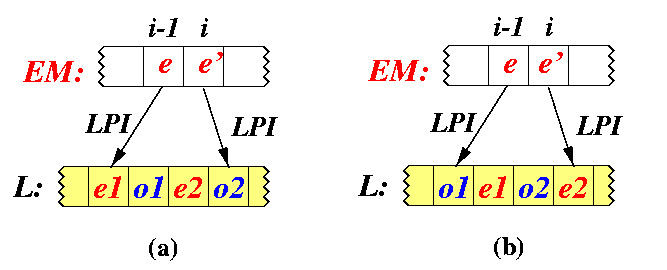
CAPTION: The maximal span between adjacent LPI or RPI is at most 2.
- Phase C:
- Let z=L[j], j odd, be a number in L-EM. It serves as a predecessor for at least one number in EM, but there may more numbers in EM, whose LPI points to z. Let e=EM[i] be the least (the leftmost) one among them. Then clearly LPI[i]\not =LPI[i-1] and e'=EM[i-1] must be less than z. But since e' precedes immediately e in EM, it is the greatest number in EM less than z. A detailed analysis reveals that only 2 different situations can appear and in both of them LEMPI[j]=i-1. Figure illustrates all cases.
- case (a):
- LPI[i-1]=j-1. Let x=L[j-1] and y=L[j+1] be the neighbors of z in L, both must appear in EM. Then x < e' < z < e<= y.
- case (b):
- LPI[i-1]=j-2. Let x=L[j-1] and y=L[j-2]. Then x must appear in EM. At the same time, e'<= x (since y < x and y is the greatest number in L less than e') and x < e (since x < z and z < e). So x must appear in EM before e, but not before e'. It is possible only if x=e' and then LEMPI[j]=i-1.
- case (c):
- This case cannot appear due to Proposition .
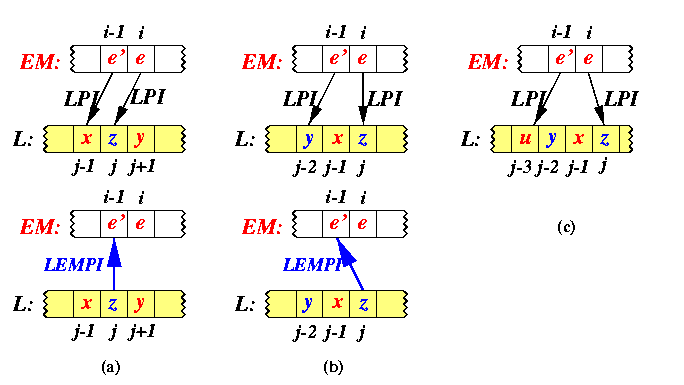
CAPTION: Calculation of indexes LEMPI.
The indexes in the array LEMPI and REMPI in our example are shown on Figure

CAPTION: The indexes LEMPI and REMPI pointing to EM to predecessors of numbers from L-EM and R-EM.
- Phase D:
- We will give the proof only for case D2, since D1 is trivial and D3 is analogous to D2.
To compute the final position for numbers from L-EM, we must know for each of them how many numbers precede them in R. Consider any k=L[i], i is odd. Let j=LEMPI[i], e=EM[j], e'=EM[j+1], r=R[RPI[j]], r'=R[RPI[j+1]], and r''=R[RPI[j+1]+1].
Since k > e and e > r, we have k > r. Similarly, k<= e' and e'<= r'' implies k<= r''.

CAPTION: A generic situation for calculation of number of predecessors of numbers from L-EM in R.
From Proposition we know that the interval (r,r') can contain at most two numbers.
A detailed analysis again reveals that among four possible cases, only two can really appear and the other two are handled by the algorithm. See Figure for all four situations.
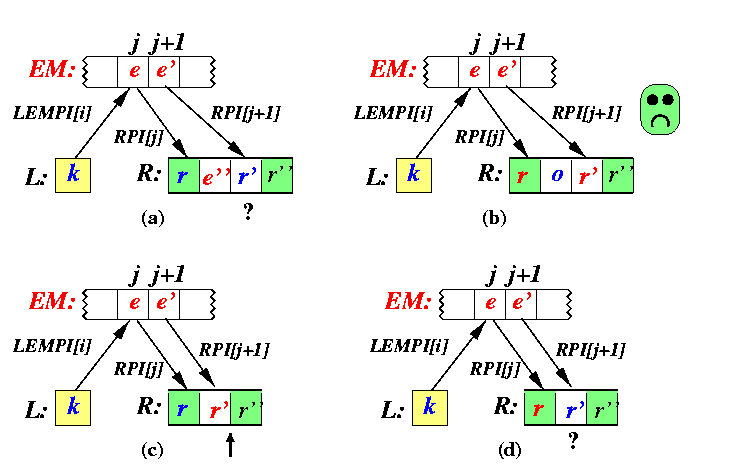
CAPTION: All cases for calculation of number of predecessors of numbers from L-EM in R.
- case (a):
- Both r and r' are 1 apart and are on odd positions. It follows that r < e'' < r' < e' and r < e < e' and r < e < k. Then e=e'', since all other cases lead to a contradiction. But then > e'' and the only uncertain number w.r.t. k is r'.
- case (b):
- Both r and r' are 1 apart and are on even positions. In this case, we have r < e<= o < r' < e', but this is a contradiction, since r' is at even position and would have to appear between e and e'.
- case (c):
- r is on odd position and r' is adjacent. Then r < e<= r' < e' implies r'=e and so k > r'.
- case (d):
- r is on even position and r' is adjacent. Since e < k < e' and e<= r' < e', we must compare k with r'.
To conclude, in order to determine the exact position of k with respect to numbers in R, it must be compared with r'.
Complexity of Cole's EREW PRAM Merge Sort
Theorem
The algorithm EffMerge requires at most 4N comparisons to merge two sorted sequences of length N. Its parallel time is T(2N,N)=O(log N).
Proof
Both Phases A and C perform at most N comparisons and the same for Phase D plus some O(1) operations per number. The solution of cm(2N)<= cm(N)+2N is cm(2N)<= 4N. If we use N processors, each of them can alternatively take care of one number in EM and one number in L\cup R-EM, so that one stage takes O(1) time and the number of stages is O(log N).
This implementation would be time-optimal, but not cost optimal, since the complexity of a merge operation of 2 N-number sequences is SU(2N)=O(N), whereas C(2N,N)=O(Nlog N). But we can scale easily this algorithm to get an optimal cost.
Theorem
The EffMerge takes parallel time O(log N) using N/log N processors.
Proof
If we have only N/log N processors, each of them takes care about log N numbers, alternatively in EM and L\cup R-EM. The first stage therefore performs \alpha log N parallel comparisons plus auxiliary operations, where \alpha>= 4 is a constant. The recursive call of EffMerge takes input sequence of half size, so that the time is (\alpha log N)/2, the next recursion needs (\alpha log N)/4, and so on, until the loglog N-th recursive call decreases the number of numbers to be merged to N/log N. Since this moment, the number of available processors will be higher than the size of the input sequences and each recursive call will take only a constant time. The total time is therefore
T(2N,N/log N)=\alpha O(log N+(log N)/2+(log N)/4+...+1+...+1)
where the number of first nonconstant terms is loglog N and the remaining log N-loglog N terms are constant. Clearly, this sum is bounded by \alpha 3log N.
Theorem
The Cole's Merge Sort performs at most 2Nlog N comparisons to sort N numbers. It runs in parallel time O(log2N) using N/log N processors.
Proof
The total number of CE operations per stage is at most 2N (EffMerge of two sequences of length N/2). The number of merge stages is log N which gives the cost. Each stage takes parallel time log N on N/log N processors.









